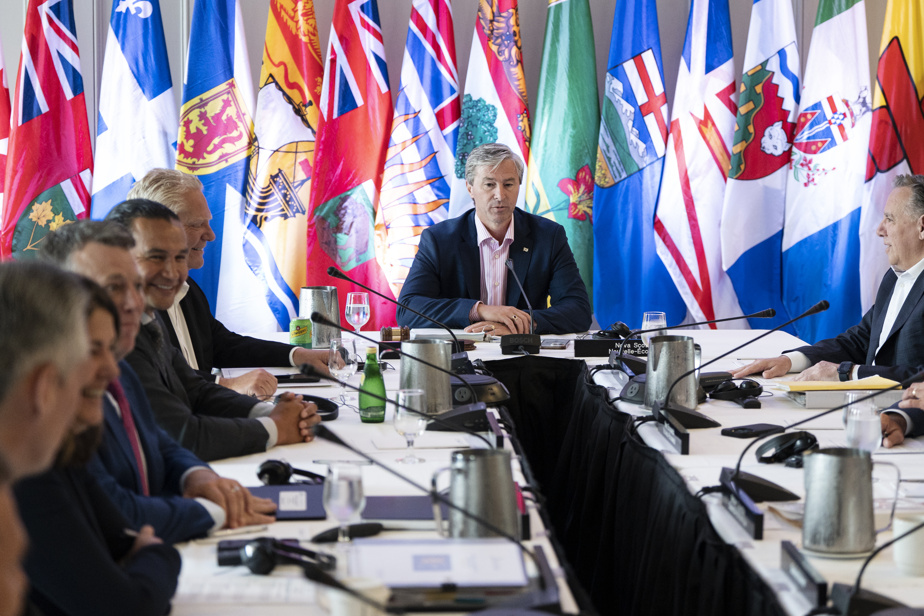(Halifax) As Canada’s premiers discussed housing, health care and their contentious relationship with Ottawa at their meetings last week in Halifax, many remained consumed by climate-related natural disasters, which have only intensified since returning to their respective provinces.
“It is clear to us that emergency preparedness for natural disasters is more important than ever,” said Nova Scotia Premier Tim Houston in his closing remarks on the final day of the Council of the Federation conference.
Canada’s provincial and territorial premiers gathered for three days of meetings, and discussion of ongoing natural disasters was a constant topic of discussion, Houston said.
This summer has so far been marked by multiple flash floods, including one this month in Nova Scotia that killed a 13-year-old boy, and wildfires across the country that have destroyed property and forced thousands of residents to evacuate.
“There are a number of premiers around the table today who are battling wildfires. Of course, here in this province, we had a tragic loss of life due to flash flooding last week,” the premier said on the second day of the meeting. On July 11, Eli Young was swept into a ditch in a park in Wolfville, N.S., during a flash flood that caused significant damage in the western part of the province.
“Of course, discussions about emergency preparedness certainly take on added meaning and importance at a time like this,” he said.
Insufficient discussions
Blair Feltmate, director of the Intact Centre on Climate Adaptation at the University of Waterloo, says discussion is not enough. He said in an interview Wednesday that all levels of government need to treat the escalation of climate-related natural disasters as a crisis and move quickly to adopt mitigation strategies before things get worse.
Mr. Feltmate said there are disaster mitigation strategies that governments could implement. “The problem is they’re not deploying the known solutions quickly enough,” he said.
“This is a red alert type situation. Not only is the level of risk extremely high, but we realize that it will only increase. As bad as the situation is now with floods, wildfires and extreme heat, it will get worse. Climate change is irreversible,” he explained.
Northern Canada, which has also seen recent wildfires, is suffering from a drought that has caused water levels in the Mackenzie River to drop to the point where barges can no longer travel on it.
“We’re facing a situation right now where climate change has resulted in the lowest water levels we’ve ever seen on the Mackenzie River – it’s basically our highway,” Northwest Territories Premier RJ Simpson said last week at the premiers’ conference.
Mr. Simpson called for federal support for communities that rely on Canada’s longest river to access essential goods and food, as well as urgent funding to build the Mackenzie Valley Highway project to provide an alternative to river transportation.
“We’re now in a situation where people are essentially stranded, we have to airlift goods, which is going to double the price that the consumer is going to pay at the grocery store… It’s delaying the construction of new infrastructure. It’s a serious problem that we’re facing,” the prime minister detailed.
Preventive measures to be implemented
Since last week’s meetings, many wildfires in Western Canada have increased significantly.
As of Wednesday, British Columbia had about 430 active wildfires, including 107 that started in the previous 24 hours. Residents of about 470 properties across the province have also been forced to evacuate. About 20 buildings have been destroyed by the Shetland Creek wildfire, including at least six homes. Wildfire officials say 8,099 square kilometres of the province has burned since April 1er april.
In Alberta, wildfire officials say about 20,000 to 25,000 people have evacuated the community of Jasper since Monday night. About 180 wildfires were burning in Alberta Wednesday night, and about a third of them were considered out of control.
Feltmate said concrete measures to mitigate wildfires are included in Canada’s wildfire prevention and mitigation strategy, released by Ottawa on June 5. That report recommends “proactive” fire prevention techniques such as prescribed burns, removing hazardous fuels like dry shrubs and grasses, and educating the public on how to limit human-caused wildfires.
The Intact Centre on Climate Adaptation has also released guides for individuals to mitigate the risks of wildfires, extreme heat and flooding. Recommendations include removing mulch and plants from near homes if they are in a wildfire-prone area, checking for plumbing leaks, and using heat-resistant curtains and fans to cool the home during a heat wave.
More expensive recommendations include installing a sump pump, adding fireproof screens to external vents, and replacing wooden fencing near the home with wire or metal fencing.
“The good news is we know where the problems lie, we know where the key areas are that are at greatest risk of flooding, wildfires and extreme heat,” Feltmate said. “Now we need to act urgently.”
